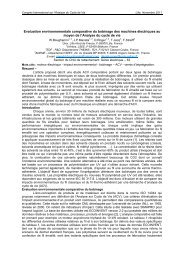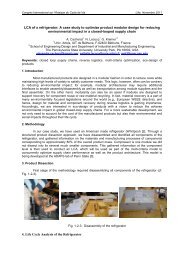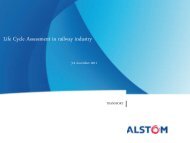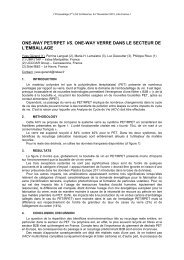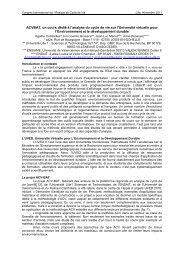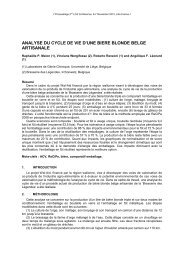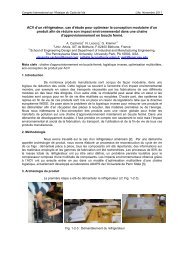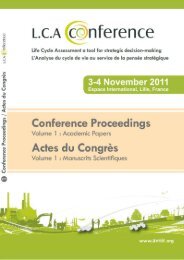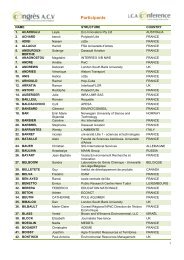Assessing Temporary Carbon Storage in Life Cycle Assessment and ...
Assessing Temporary Carbon Storage in Life Cycle Assessment and ...
Assessing Temporary Carbon Storage in Life Cycle Assessment and ...
Create successful ePaper yourself
Turn your PDF publications into a flip-book with our unique Google optimized e-Paper software.
1 Introduction<br />
L<strong>and</strong> <strong>and</strong> wood-based products, among others, represent temporary carbon s<strong>in</strong>ks. S<strong>in</strong>ce the embodied<br />
carbon is reta<strong>in</strong>ed outside the atmosphere for a period of time, some radiative forc<strong>in</strong>g is postponed.<br />
<strong>Carbon</strong> removal from the atmosphere <strong>and</strong> storage <strong>in</strong> the biosphere or anthroposphere, therefore, may<br />
have the potential to help mitigate climate change.<br />
<strong>Life</strong> cycle assessment (LCA) <strong>and</strong> carbon footpr<strong>in</strong>t<strong>in</strong>g (CF) are <strong>in</strong>creas<strong>in</strong>gly popular tools for the<br />
environmental assessment of products that take <strong>in</strong>to account their entire life cycle; from the extraction<br />
of raw materials through to their end-of-life. A robust method is therefore required to account for the<br />
benefits, if any, of temporary carbon storage for use <strong>in</strong> these environmental assessment approaches.<br />
Despite significant efforts, there is still no consensus on how to best consider this.<br />
This workshop brought together experts on climate change, carbon footpr<strong>in</strong>t<strong>in</strong>g <strong>and</strong> life cycle<br />
assessment to review available options <strong>and</strong> to discuss the most appropriate method for account<strong>in</strong>g for<br />
the potential benefits of temporary carbon storage. The workshop cont<strong>in</strong>ued the work developed under<br />
the International Reference <strong>Life</strong> <strong>Cycle</strong> Data System (ILCD) [1], which provides methodological<br />
recommendations for use <strong>in</strong> bus<strong>in</strong>ess <strong>and</strong> policy for assess<strong>in</strong>g the environmental impacts of goods <strong>and</strong><br />
services, tak<strong>in</strong>g <strong>in</strong>to account their full life cycle.<br />
This report is a summary of the presentations <strong>and</strong> discussions held dur<strong>in</strong>g this workshop. Sections 1 to<br />
4 sum up the pr<strong>in</strong>cipal topics of the four sessions of presentations given by experts, <strong>in</strong>clud<strong>in</strong>g<br />
discussions. Section 5 gives the f<strong>in</strong>al conclusions <strong>and</strong> recommendations com<strong>in</strong>g from these<br />
discussions. F<strong>in</strong>ally, the abstracts provided by the different speakers are found <strong>in</strong> the Appendix (see<br />
Section 7).<br />
1.1 Background<br />
There is <strong>in</strong>creas<strong>in</strong>g <strong>in</strong>terest <strong>in</strong> account<strong>in</strong>g for temporary carbon storage <strong>in</strong> the LCA <strong>and</strong> CF of products.<br />
Current LCA methodology does not consider giv<strong>in</strong>g any benefits to temporarily keep<strong>in</strong>g carbon out of<br />
the atmosphere. Indeed, s<strong>in</strong>ce the tim<strong>in</strong>g of emissions is not considered, the amount of carbon<br />
sequestered <strong>in</strong> biomass (negative emission) is simply added to the amount of carbon released at the<br />
product end-of-life (positive emission), which results <strong>in</strong> carbon neutrality. No additional credits are<br />
given for the time of storage.<br />
Some recently published st<strong>and</strong>ards <strong>and</strong> methods, such as the British PAS 2050 [2] <strong>and</strong> the European<br />
Commission’s ILCD H<strong>and</strong>book [1], propose a way to account for the tim<strong>in</strong>g of GHG emissions <strong>in</strong><br />
1



